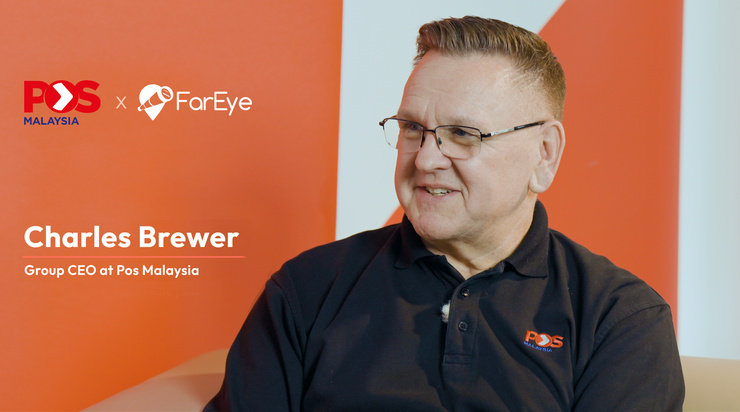- Logistics
Forward Logistics: How to Optimize Delivery from Warehouse to Customer
Waiting four to five days for a delivery used to feel fast. Now it feels like the wait is too long. If a package isn’t at your doorstep a day or two after the confirmation email hits your inbox, something isn’t right about that Customer expectations are constantly on the rise and SLAs are shrinking.
But, behind every "Your order has been delivered" message, there’s a whole web of warehouses, carriers, routes, and systems making that happen. That’s forward logistics you're seeing in action. It's the part of your supply chain that handles all the heavy lifting needed when a product leaves the warehouse to be delivered to a customer.
It often runs quietly in the background until something goes wrong. A missed delivery window, a routing delay, or inventory mismatch can quickly ripple into customer complaints, mounting costs, and strained teams.
In this blog, we’ll unpack what forward logistics is all about, explore the building blocks of a well-oiled operation, and show you how to level it up with the right tools and strategies.
Forward Logistics Explained
What is Forward Logistics and its Role in the Supply Chain?
Forward logistics refers to the movement of goods from the warehouse or distribution centers to the end customer. It includes order picking, packing, shipping, delivery, and all the operational touchpoints in between.
It sounds simple on paper. But in practice? It's a maze of moving parts. Carriers need coordination. Inventory needs accuracy. Routes need constant adjustment. And everything needs to run on time, every time.
This is the stretch of the supply chain that customers actually notice. They don’t see your inventory system or warehouse layout. They see whether the box shows up when you said it would, and in one piece. If it doesn’t, well, then the entire brand takes a hit, no matter how good everything else was.
So while forward logistics might be invisible to the end customer, it carries more weight than most of them. It’s the last mile, the final impression, and often, the reason a customer comes back, or doesn’t.
The Significance of Optimized Forward Logistics in Customer Satisfaction
A late delivery, vague tracking updates, or one dented box can immediately urge a customer to leave a "How can they?!" review. In fact, 85% of customers say rapid delivery directly influences how satisfied they feel with a brand. That number alone puts logistics right at the heart of customer experience, not somewhere off to the side with backend operations.
But it’s not just about speed. It’s about smoothness. No hiccups. No guessing games. When a customer hits the "place order" button, we need to give them the confidence that things are moving, by providing clear visibility and live updates into what's happening.
That’s why 58% of customers say they’re more loyal to brands that offer seamless delivery, because it signals reliability.
Optimizing forward logistics helps businesses meet these rising expectations. It turns delivery from a cost center into a competitive edge. The more predictable your fulfillment is, the more trust you earn. And in an age where people remember every late package, that trust can be worth more than the product inside the box.
Key Elements of Efficient Forward Logistics
Warehouse and Inventory Management
Warehouses that move with precision give delivery operations a real advantage. When every item has its place, and every scan reflects the real-time stock, orders can be picked, packed, and pushed out without delay.
Keeping products in the right spot reduces time spent wandering aisles or rechecking bins. It frees up warehouse teams to move fast and focus on accuracy, not on chasing missing items or double-checking spreadsheets. That kind of clarity pays off quickly. Fewer delays. Fewer wrong shipments. Fewer internal headaches.
Inventory systems that talk to the rest of the supply chain make everything click. They remove the bottlenecks that slow teams down and replace them with flow. When stock data is current and synced, the delivery side can run tight schedules without the fear of last-minute stockouts.
In short, organized warehouses create reliable launchpads. Without that foundation, even the fastest trucks and smartest software won’t keep things on track.
Route Optimization and Efficient Transportation Planning
Well-planned routes save more than just time. They unlock consistency. When deliveries follow smart, data-driven paths, carriers avoid delays, cut down fuel waste, and hit delivery windows with confidence.
Route optimization tools factor in traffic, distance, weather, vehicle capacity, and customer availability. This level of planning removes the guesswork from daily dispatches. Drivers get fewer surprises. Customers get fewer excuses.
Efficient transportation planning adds another layer. It connects the route to the bigger picture like shipment volumes, delivery priorities, fleet availability. Planning like this helps businesses get rid of any last-minute reshuffling and overloaded vehicles that might throw the delivery timelines off balance.
All of this together makes the whole supply chain process smoother. Orders leave the warehouse at the right time, follow the smartest route, and land where they should. No surprises along the way. That’s the kind of logistics rhythm customers feel, even if they don’t see it.
Real-Time Shipment Tracking and Enhanced Visibility
Tracking is part of the delivery experience and customers want updates that feel live. They expect to see progress, not a simple "In-transit" placeholder. Real-time tracking gives them that sense of control, something they quietly count on when they’re waiting at the door.
For operations, visibility turns into foresight. You don’t need to wait for a delay to cause problems. You spot it early, make a call, and keep things moving. That kind of awareness smooths out the chaos that usually creeps in during last-mile delivery.
It also cuts down the noise. When customers can follow the journey themselves, there’s less back and forth. Fewer “just checking in” messages. Fewer support requests clogging up your team’s inbox.
And when there’s a bump in the road, visibility helps you respond with context. Instead of scrambling, you’re adjusting. That difference alone can shift how a customer feels about the entire delivery.
Effective Returns and Reverse Logistics Integration
Returns are part of the deal. No matter how smooth your delivery process is, some orders will come back. The key is making sure that return doesn’t feel like a setback, for you or the customer.
A clear, flexible return process gives customers peace of mind. They don’t have to second-guess their purchase. They know that if something doesn’t work out, there’s a simple way to send it back and move on.
Behind the scenes, reverse logistics needs to run with the same care as forward delivery. Products should flow back into your system quickly, without clogging up warehouses or confusing your inventory records. When returns are tracked and processed in real time, the business stays agile.
And here’s the real gain: a well-handled return can still lead to loyalty. Customers remember when it was easy. They also remember when it wasn’t. An efficient reverse logistics system turns what could’ve been a negative experience into another chance to build trust.
Strategic Benefits of Optimizing Forward Logistics
Accelerated Delivery Times and Improved Service Levels
Fact: 92% of customers say they are more likely to shop again if delivery was on time
When forward logistics runs smoothly, delivery speeds up without anyone needing to push harder. Orders leave the warehouse faster, follow smarter routes, and show up within the time customers expect.
This kind of consistency improves more than just metrics. It builds confidence. Sales teams start making tighter delivery promises because they know fulfillment can keep up. Customer support hears fewer complaints. Everyone downstream feels the difference.
Faster delivery also unlocks flexibility. When shipments arrive on time, rescheduling becomes rare. Teams spend less time fixing problems and more time scaling what already works.
The result is a delivery experience that feels reliable and easy for customers and for the teams behind it.
Reduced Operational Costs and Enhanced Profitability
Every minute saved in delivery planning, every avoided reroute, and every accurate inventory update adds up. When forward logistics is optimized, those small gains start showing up in the numbers.
Fuel costs drop when drivers follow shorter, smarter routes. Labor becomes more efficient when teams don’t have to chase down delays or fix inventory errors. Even packaging gets tighter when systems are in sync with what’s being shipped.
Better coordination leads to fewer surprises. And fewer surprises mean fewer expensive fixes, like rush shipping, missed deliveries, or duplicated work.
Over time, this level of control creates breathing room in your margins. Logistics shifts from being a cost center to becoming something that directly supports profitability.
Higher Customer Retention and Brand Loyalty
People don’t always say it out loud, but they remember how delivery felt. Was it smooth? Was it on time? Did it work as promised?
Those details stick. And when everything clicks into place, like when the order shows up exactly how and when it should, that experience creates confidence. The kind that makes someone reorder without hesitation.
Smooth logistics reduces friction. It keeps things quiet. Fewer delays, fewer calls to support, fewer reasons to hesitate. Customers start trusting the process, and when they trust it, they lean in. They come back without being asked.
Over time, this turns into brand preference. Not because of one flashy campaign, but because everything around the purchase felt calm, clear, and easy. That’s loyalty earned quietly, one delivery at a time.
How FarEye Empowers Forward Logistics Optimizations
Intelligent Route Optimization for Maximum Efficiency
Fareye’s AI/ML routing engine provides optimized delivery plans in real time. It considers constraints such as driver schedules, vehicle capacities, time windows, and specific delivery requirements, and for multiple fleet types - owned/captive, hybrid, and outsourced deliveries.
It also equips you with dynamic route updates that adjust for disruptions like traffic or order changes, keeping ETAs accurate and deliveries on time. On top of that, FarEye's loop optimization helps you schedule complex runs by letting you handle thousands of shipments in minutes.
This makes sure that customers receive tighter windows, drivers hit more stops per hour, and increase delivery speeds by 27%.
Real-time Tracking to Keep Customers Informed
Fareye Track gives stakeholders visibility into every mile, surface, rail, ocean, through real‑time shipment status updates and carrier integrations. It also offers predictive delivery time (EDD) based on port-level data. The centralized control‑tower view unifies data from in‑house and outsourced carriers, enabling seamless visibility.
With this visibility, logistics teams can surface risks early, reroute shipments, and increase OTIF score by 56%.
Seamless Integration with Your Existing Logistics Processes
FarEye’s integration feature comes with plug‑and‑play APIs that connect directly to systems like TMS, WMS, ERP, and carrier systems. That creates a unified flow from order management to delivery execution. Orchestration workflows are configurable via low‑code tools, enabling operations teams to adapt carrier onboarding, SLA rules, and dispatch logic without coding cycles.
This level of integration removes silos, keeps data current, and enables fast scaling without disruption.
Proactive Issue Resolution with Predictive Analytics
Fareye uses predictive analytics to flag delivery risks before they escalate. For example, it allows businesses to anticipate demand and optimize inventory levels, minimizing stockouts and excess inventory. This helps teams stock up where it’s needed before orders stack up. It keeps warehouses efficient and orders fulfilled without scramble.
In practice, this coordination means fewer missed deliveries, fewer frustrated customers, and less firefighting. The predictive layer gives teams time to adapt rather than just react. It adds calm to complexity and keeps logistics performance tight.
Ready to Boost Your Forward Logistics Performance? Book a demo with us!
Tracking Success: Metrics to Evaluate Forward Logistics Efficiency
Tracking your forward logistics requires certain metrics that you need to monitor. Here are some important Key Performance Indicators (KPIs) that you need to look out for:
| KPI | What is it? | Why do we need it? |
| On-time Delivery Rate | It measures the percentage of shipments delivered on time. | It indicates the reliability of your logistics operations and ability to meet delivery expectations. |
| Order Accuracy | It tracks how many delivered orders match the original order request. | It reflects the customer experience and reduces returns. |
| Cost Per Unit | It calculates the average transportation cost per unit shipped. | It helps analyze transportation efficiency. |
| Inventory Turnover | It measures how often inventory is sold or dispatched during a period. | Higher turnover means less stock lying idle. |
| Transportation/vehicle Utilization Rate | It shows how effectively you use your trucks or other shipment consignments. | Improving this metric directly affects the Cost Per Unit metric. |
| Average Service Time | It is the total amount of time that is spent in fulfilling a single order. | Shorter service times leads to faster fulfillment of shipments. |
Conclusion
Forward logistics shapes the customer experience long after the checkout button is clicked. When warehouses run smooth, routes stay sharp, and updates flow in real time, delivery starts to feel dependable. And dependable delivery builds repeat business.
Optimizing this part of the supply chain isn’t about overhauling everything. It’s about refining what already exists. Smarter planning, cleaner handoffs, better visibility. These are small shifts that create a big impact.
With the right tools in place, logistics stops being a scramble. It becomes something you can trust to run day after day, order after order.
The brands that win are the ones that treat logistics as a front-line experience, not just a back-end task. Customers notice. And they come back when it feels right.

Komal Puri is a seasoned professional in the logistics and supply chain industry. As the AVP of Marketing and a subject matter expert at FarEye, she has been instrumental in shaping the industry narrative for the past decade. Her expertise and insights have earned her numerous awards and recognition. Komal’s writings reflect her deep understanding of the industry, offering valuable insights and thought leadership.
Let's Talk to Our Experts and Optimize Your Deliveries Today!
An expert from our team will reach out within 24 hours


